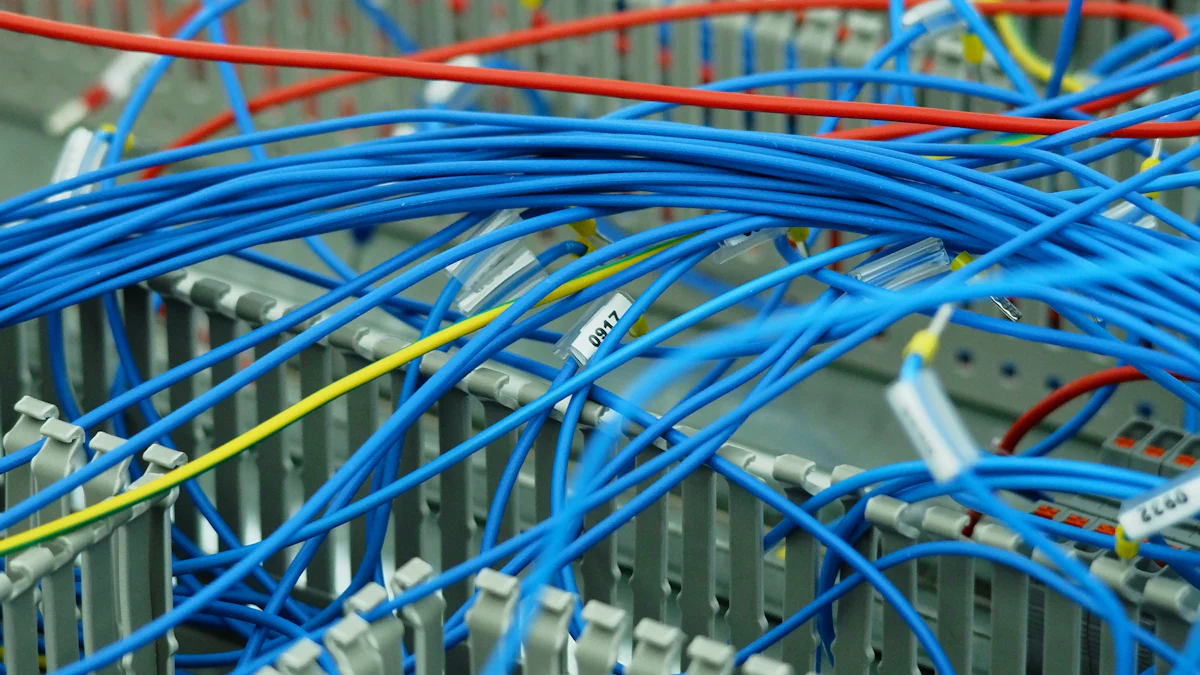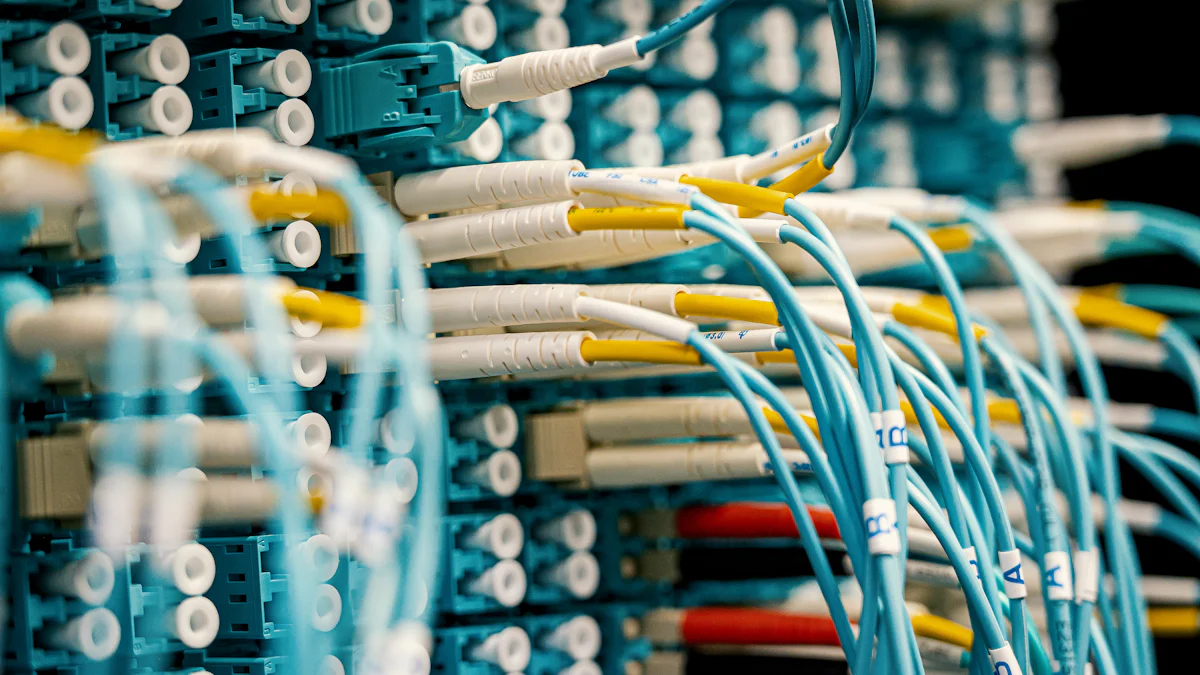
News

Induction heating technology is transforming the optical fiber manufacturing industry induction heating by tackling inefficiencies and reducing high costs. With the use of an Induction Heating Machine, you can achieve up to 50% energy savings and extend the lifespan of graphite to six months, significantly lowering operational expenses. Additionally, an Induction Heater Machine helps minimize argon gas consumption and reduces CO2 emissions by 225 g per fiber kilometer, promoting sustainability and improving resource efficiency.
Key Takeaways
Induction heating can cut energy costs by up to 50%. This helps manufacturers save money on operations.
It reduces carbon emissions, lowering CO2 by 225 g per fiber kilometer. This supports a cleaner and greener environment.
Induction heating improves product quality with accurate temperature control. This reduces defects and makes optical fibers stronger.
Challenges in the Optical Fiber Manufacturing Industry
High energy consumption and inefficiencies
The optical fiber manufacturing process demands significant energy at every stage. You encounter energy-intensive steps such as mining quartz, which involves heavy machinery, and extracting pure oxygen through methods that require liquefying air. Additionally, processes like Modified Chemical Vapor Deposition (MCVD) rely on superheating materials to extremely high temperatures. These steps, combined with the need for precise control of temperature and pressure during vapor deposition and fiber drawing, contribute to high energy consumption. This inefficiency not only increases operational costs but also limits scalability in production.
Environmental impact and carbon emissions
Environmental concerns are a growing challenge in the optical fiber manufacturing industry. You must comply with strict regulations such as RoHS, WEEE, and CE marking, which aim to reduce hazardous substances, promote proper recycling, and ensure environmental safety. Despite these measures, traditional heating methods release significant carbon emissions, exacerbating climate change. For instance, the use of argon gas and fossil fuels in conventional processes adds to the industry's carbon footprint. Transitioning to sustainable technologies like induction heating can help you address these challenges by reducing CO2 emissions and promoting eco-friendly practices.
Quality control and material longevity issues
Maintaining consistent quality in optical fiber production is critical for ensuring material longevity. You face challenges in controlling draw temperature, speed, and tension during fiber drawing, which directly affect uniformity and strength. Improper alignment during cable assembly can lead to microbending losses and fiber breakage. Additionally, environmental factors such as exposure to high temperatures or moisture can accelerate crack growth in fibers. To mitigate these risks, you must adopt rigorous quality control measures, including regular inspections and the use of durable coatings to protect fibers from degradation. These steps ensure the reliability and durability of the final product.
How Induction Heating Technology Works

The science of electromagnetic induction
Electromagnetic induction forms the foundation of induction heating technology. This principle, based on Faraday's Law, explains how a changing magnetic field generates an electromotive force in a conductor. When you pass high-frequency alternating current through an induction coil, it creates a rapidly fluctuating magnetic field. This field induces eddy currents in the material being heated, producing heat through the Joule heating effect. The process ensures rapid and uniform heating, making it ideal for applications requiring precise temperature control. In the optical fiber manufacturing industry, induction heating offers unmatched efficiency and safety, addressing the challenges of traditional heating methods.
Applications in optical fiber manufacturing
Induction heating technology plays a pivotal role in several stages of optical fiber production. You can use it to preheat quartz rods before drawing fibers, ensuring consistent material properties. It also proves effective in annealing processes, where controlled heating strengthens the fibers and reduces internal stresses. Additionally, induction heating is employed in coating and curing applications, providing uniform heat distribution for protective layers. Its ability to deliver precise and localized heating makes it a valuable tool for improving the quality and durability of optical fibers.
Advantages over traditional heating methods
Induction heating outperforms traditional methods in several key areas:
It converts up to 90% of energy into heat, significantly reducing energy waste.
Unlike conventional systems that heat the surrounding air, induction heating directly targets the material, minimizing energy loss.
Faster heating times and precise temperature control enhance process efficiency and reduce downtime.
Advanced systems with intelligent control enable real-time monitoring, ensuring consistent results and improved product quality.
Innovations in coil design and power electronics further optimize energy efficiency, making the process more sustainable.
By adopting induction heating, you can achieve better energy management, reduce emissions, and improve overall production efficiency in the optical fiber manufacturing industry.
Benefits of Induction Heating in Optical Fiber Manufacturing
Improved energy efficiency and cost savings
Induction heating technology revolutionizes energy efficiency in the optical fiber manufacturing process. By directly heating the material, it minimizes energy loss and reduces overall consumption by up to 50%. For instance, using an efficient Nextrom Induction Furnace can save approximately 0.25 kWh per fiber kilometer (FKM), translating to significant savings for manufacturers producing millions of FKM annually. Additionally, automatic optimization modules can cut inductor energy usage by 24%, further enhancing efficiency. These energy savings not only lower operational costs but also improve productivity by enabling quicker heating cycles. With reduced labor costs and optimized resource utilization, you can achieve substantial cost reductions while maintaining high production standards.
Reduced carbon footprint and enhanced sustainability
Induction heating supports sustainable manufacturing by significantly lowering carbon emissions. Traditional heating methods in fiber drawing processes generate up to 450 g of CO2 per FKM, contributing to approximately 9,000 tons of emissions annually for large-scale production. By adopting induction heating, you can reduce energy consumption and save around 225 g of CO2 per FKM. This reduction is equivalent to removing nearly 1,000 passenger vehicles from the road annually. The localized heating process minimizes energy waste, while advanced systems reduce grid dependency, making induction heating a cleaner and more eco-friendly alternative. These improvements align with sustainability goals, such as achieving net-zero emissions and reducing the industry's environmental impact.
Faster production cycles and scalability
Induction heating accelerates production cycles by delivering rapid and uniform heating. Unlike traditional methods, which often require extended preheating times, induction systems heat materials almost instantaneously. This speed allows you to scale production efficiently without compromising quality. For example, faster heating times enable higher throughput, meeting the growing demand for optical fibers in telecommunications and other industries. The scalability of induction heating systems ensures that you can adapt to market demands while maintaining consistent performance and reliability.
Enhanced product quality and reduced defect rates
Induction heating ensures precise temperature control, which is critical for maintaining the quality of optical fibers. Uniform heating eliminates temperature variations, reducing the risk of defects such as microbending or internal stresses. This technology also enhances the durability of fibers by improving their structural integrity during annealing and coating processes. A case study highlighted that advanced induction systems improve energy efficiency by over 35%, directly contributing to better product quality. By adopting this technology, you can achieve consistent results, reduce defect rates, and deliver superior products to your customers.
Comparing Induction Heating to Traditional Methods
Performance metrics: Energy, cost, and speed
When comparing induction heating to traditional methods, energy efficiency stands out as a critical metric. Induction heating achieves up to 90% energy efficiency, significantly outperforming gas heating at 60% and electric resistance heating at 70%. This efficiency translates to lower energy consumption, with induction systems requiring only 1.11 kW of power to deliver 1 kW of heat, compared to 1.67 kW for gas heating and 1.43 kW for electric resistance heating.
Additionally, induction heating reduces overall energy consumption by 30% and cuts energy costs by up to 44% compared to gas heating. Its rapid heating capabilities also enhance production speed, enabling a 20% increase in throughput. These advantages make induction heating a superior choice for the optical fiber manufacturing industry.
Case studies of successful implementation
Several manufacturers have successfully implemented induction heating technology to improve efficiency and reduce costs. For example, a leading optical fiber producer replaced traditional gas burners with induction heating systems. This transition resulted in a 35% improvement in energy efficiency and a significant reduction in carbon emissions.
Another case study highlighted the use of advanced induction systems in fiber drawing processes. The company achieved a 20% increase in production speed while maintaining consistent product quality. These examples demonstrate how induction heating can revolutionize manufacturing processes, offering tangible benefits in both performance and sustainability.
Long-term economic and environmental benefits
Adopting induction heating technology provides substantial long-term benefits. Energy efficiency of up to 90% reduces energy bills and operational costs, offsetting the initial investment in equipment. Faster production cycles and minimized material waste further enhance cost savings. For instance, manufacturers can save 25% annually in kilowatt usage, leading to lower utility bills.
From an environmental perspective, induction heating minimizes energy waste and reduces greenhouse gas emissions. Upgrading to advanced systems like ThermESC Intl.'s ForgeMax series can cut energy waste by over 35%, aligning with sustainability goals. Real-time monitoring systems optimize energy usage, ensuring precision and eco-friendly operations. These benefits make induction heating a transformative solution for the optical fiber manufacturing industry.
Induction heating technology is revolutionizing the optical fiber manufacturing industry induction heating by offering unmatched efficiency, precision, and sustainability. You can benefit from its environmentally friendly design, which reduces carbon emissions and aligns with global eco-conscious trends. Its high energy efficiency and cost-effectiveness make it a strategic investment for improving profitability.
The integration of advanced Human-Machine Interface (HMI) controls enhances real-time monitoring, ensuring consistent, high-quality results. This capability supports compliance with ISO 9000 standards and minimizes costly errors.
Key advantages include:
Specific heating tailored to your production needs.
Compatibility with existing infrastructure for seamless adoption.
Automation that reduces labor costs and boosts product quality.
By adopting induction heating, you can stay competitive in a rapidly evolving market while meeting the growing demand for sustainable and high-quality optical fibers.
Please give us a message